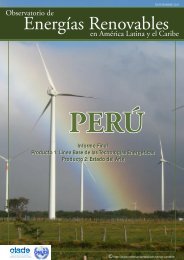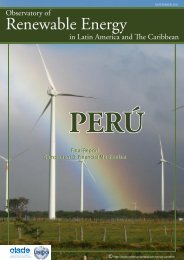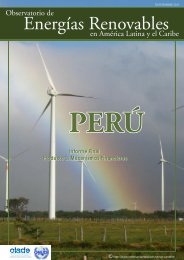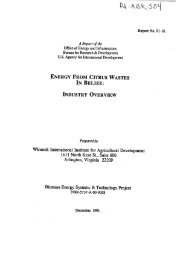PERÃ - Observatory for Renewable Energy in Latin America and
PERÃ - Observatory for Renewable Energy in Latin America and
PERÃ - Observatory for Renewable Energy in Latin America and
Create successful ePaper yourself
Turn your PDF publications into a flip-book with our unique Google optimized e-Paper software.
<br />
Perú- Products I <strong>and</strong> II<br />
<br />
In the case of electric power projects, the normative aspects of environmental<br />
affairs are <strong>in</strong> charge of the General Directorate of Energetic Environmental<br />
Affairs (DGAAE). The aspects of technical environmental control are<br />
competition of the Organism of Evaluation <strong>and</strong> Environmental Control– OEFA,<br />
belong<strong>in</strong>g to the MINAM.<br />
The EIA’s <strong>for</strong> the development of electric projects are reviewed <strong>and</strong> approved by<br />
the DGAAE. The MINAM is not implicated directly with the procedures of<br />
evaluation of Environmental Impact Assessments - EIA <strong>for</strong> projects <strong>in</strong> general.<br />
However, the National Service of Protected Natural Areas (SERNANP), which is<br />
a public agency attached to the MINAM, has the faculty of giv<strong>in</strong>g its technical<br />
b<strong>in</strong>d<strong>in</strong>g op<strong>in</strong>ion on the EIAs that <strong>in</strong>volve protected natural areas. In the same<br />
way, the National Authority of Water (ANA), a technical specialized agency, <strong>and</strong><br />
the M<strong>in</strong>istry of Agriculture, have the faculty of giv<strong>in</strong>g their technical op<strong>in</strong>ion on<br />
the EIAs. In some cases it could also be required the technical op<strong>in</strong>ion of<br />
MINAM <strong>and</strong> of the National Institute of Development of Andean, Amazonian<br />
<strong>and</strong> Afro-Peruvians (INDEPA).<br />
The request of an EIA <strong>for</strong> the development of electric power projects is <strong>for</strong>eseen<br />
<strong>in</strong> the L.D. Nº 25844, Electrical Concessions Law <strong>and</strong> its Regulations, enacted <strong>in</strong><br />
1993. The details <strong>for</strong> the EIA development are established <strong>in</strong> the S.D. Nº 29-94-<br />
EM “Regulations of Environmental Protection <strong>in</strong> Electricity Activities”, enacted<br />
<strong>in</strong> 1994.<br />
Accord<strong>in</strong>g to what is established <strong>in</strong> the L.D. Nº 25844 <strong>and</strong> the L.D. Nº 1002,<br />
(Law to Promote Investment <strong>in</strong> Electricity Generation with <strong>Renewable</strong> Energies),<br />
the presentation of an EIA <strong>for</strong> electric projects depends on the energy production<br />
capacity of the power station. For projects with higher capacity of 20 MW it is<br />
required a detailed EIA. In projects of less capacity it has been applied the prequialification<br />
mechanism <strong>and</strong> an affidavit <strong>in</strong> case the renewable energetic project<br />
is not located <strong>in</strong> a Protected Natural Area.<br />
Projects of 20 MW of power or more should be elaborated <strong>in</strong> accordance with<br />
what it is established <strong>in</strong> the Law Nº 25844, Law Nº 27446 <strong>and</strong> the S.D. Nº29-94<br />
EM. The procedures to follow <strong>for</strong> the EIA’s approval are described below:<br />
a) Presentation of a Citizen Participation Plan (CPP) <strong>and</strong> Terms of Reference<br />
(ToR) of the EIA (the ToR are sent to SERNANP, ANA <strong>and</strong> other <strong>in</strong>terested<br />
organisms when necessary).<br />
b) Execution of workshops be<strong>for</strong>e the elaboration of the EIA (preparatory<br />
phase) <strong>and</strong> dur<strong>in</strong>g the elaboration of the EIA (<strong>in</strong>termediate phase).<br />
c) Presentation of the EIA to the DGAAE-MEM <strong>and</strong> other <strong>in</strong>terested<br />
organisms (SERNANP, ANA, MINAG, DREM, district <strong>and</strong> prov<strong>in</strong>cial<br />
municipalities, communities, small towns).<br />
d) Evaluation <strong>and</strong> approval of the Executive Summary of the EIA <strong>and</strong> other<br />
requirements of the TUPA.<br />
60









